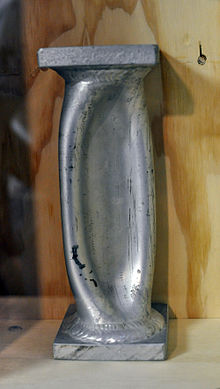
Bar (unit)
Unit of pressure equal to 100,000 Pa / From Wikipedia, the free encyclopedia
Dear Wikiwand AI, let's keep it short by simply answering these key questions:
Can you list the top facts and stats about Bar (unit)?
Summarize this article for a 10 year old
The bar is a metric unit of pressure defined as 100,000 Pa (100 kPa), though not part of the International System of Units (SI). A pressure of 1 bar is slightly less than the current average atmospheric pressure on Earth at sea level (approximately 1.013 bar).[1][2] By the barometric formula, 1 bar is roughly the atmospheric pressure on Earth at an altitude of 111 metres at 15 °C.
| bar | |
|---|---|
 A pressure of 700 bar flattened this length of aluminium tubing of wall thickness 5 millimetres (0.20 in). | |
| General information | |
| Unit system | Metric system |
| Unit of | pressure |
| Symbol | bar |
| Conversions | |
| 1 bar in ... | ... is equal to ... |
| SI units | 100 kPa |
| CGS units | 106 Ba |
| US customary units | 14.50377 psi |
| Atmospheres | 0.986923 atm |
The bar and the millibar were introduced by the Norwegian meteorologist Vilhelm Bjerknes, who was a founder of the modern practice of weather forecasting, with the bar defined as one megadyne per square centimeter.[3]
The SI brochure, despite previously mentioning the bar,[citation needed] now omits any mention of it.[1] The bar has been legally recognised in countries of the European Union since 2004.[2] The US National Institute of Standards and Technology (NIST) deprecates its use except for "limited use in meteorology" and lists it as one of several units that "must not be introduced in fields where they are not presently used".[4] The International Astronomical Union (IAU) also lists it under "Non-SI units and symbols whose continued use is deprecated".[5]
Units derived from the bar include the megabar (symbol: Mbar), kilobar (symbol: kbar), decibar (symbol: dbar), centibar (symbol: cbar), and millibar (symbol: mbar).